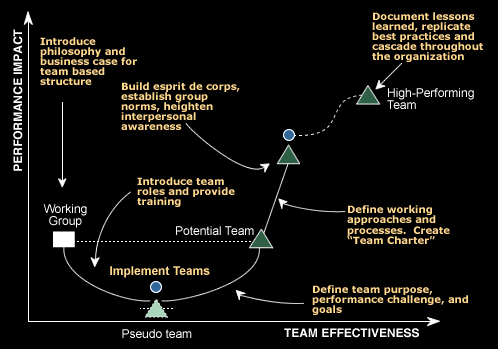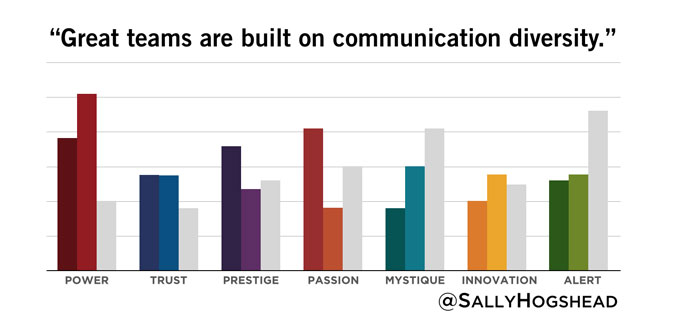Great!

With a great team, team members arrive each morning looking forward to the day’s challenges, not dreading them. Each person feels like they are a valuable component, rather than an easily-replaced cog in a machine.
A high-performing team is different than other groups because it stimulates itself. Once the right pieces are together, the team becomes self-sustaining. It creates its own goals, meets them, and creates more. It builds long-term processes designed to lift and support a business. Team members are emotionally invested in the company. They require little to no daily management.
Bad teams are plagued by disagreement, conflict, and politics. People are afraid to voice their opinions. They’re encouraged to keep their heads down. At any time, someone can be thrown under the bus for another’s mistake. No one lunches together and everyone spends the day watching the clock. These types of teams are tremendously unproductive and their ineffectiveness can bleed to other parts of the company.
Managers of any department spend a considerable amount of time and energy improving the performance of their teams or cross functional teams. They want people to work better, work faster, and innovate more solutions. Fancy offices and a funded bank account are irrelevant if you don’t have the right people to do the work.
[Tweet “Fancy offices and a funded bank account are irrelevant if you don’t have the right people to do the work.”]
This is even more important in Customer Success. Here, the team is tasked with solving customer problems before they happen. This requires forward-thinking and proactivity that is almost exclusively found in high performers.
With the right leadership, a working group can be transformed into an effective team.

So how do we go about building a high-performing team?
1. Choose people that fit
A high-performing team has people with the right strengths that support the team’s purpose. In Customer Success, that means being built to serve. Team members should be givers, who feel incredible when they support their customers’ goals. If you put a salesman in a success role, you’re setting him up for frustration and poor performance.
Discovering a team member’s (or would-be team member’s) strengths can be challenging. Asking the person about their talents helps, but often people can’t articulate their skills. It’s an ongoing process that you’ll regularly evaluate.
You can have your team take out-of-the-box personality tests, but you may find it easier to identify strengths that relate to your business and process. For instance, if your process calls for regular check-in calls to customers, you’ll need a strong communicator. Find the person with the strongest communication skills and assign them this task.
2. Pull, don’t push
Leaders of highly performing teams pull their team members to success, rather than drive them to it. They instill enthusiasm and energy in the team. They align the goals of the team with the goals of the individuals so success becomes symbiotic.
If you find the right people, this should be simple. Driven people working toward a common purpose will find ways to do excellent work. All you have to do is give them direction and the tools they need.
Leadership expert Kevin Eikenberry has some great advice on infusing energy into your team.
3. Provide honest evaluations
Performance reviews feel “corporate” only when they’re handled badly. If each team member is reviewed regularly and honestly, the evaluations can actually feel liberating. We all can’t be superstars, so don’t expect everyone to be good at everything. Is the employee using his strengths well? Is he exercising his weaknesses, but smartly passing the ball when he’s in a difficult situation?
An evaluation is also where you identify a weak point in your team. I strongly recommend doing everything you can to develop a team member before replacing him, but sometimes the success of the team hinges on the removal of a person. Evaluations allow you to discuss problems and present opportunities to improve.
4. Recognize individual and group achievements
People want to be recognized publicly for their contributions and achievements. Sometimes recognition can be bonus compensation, but often they want others to know when they’ve done something exceptional. They aren’t willing to brag, so managers have to do it for them.
The beauty of recognition is that it can be entirely free. Communicate openly to your team and the rest of the company about the successes of its members. Who had a productive week? Who saved an on-the-ledge account? Who built a process that will save everyone time?
5.Communicate constantly

Image: howtofascinate.com
The most remarkable teams in the world communicate with one another obsessively. They create a culture of communication that puts everything on the table. No topic is off limits.
In fact, the Harvard Business Review found that big super-productive companies are embracing the collaborative team model. “ […] time spent by managers and employees in collaborative activities has ballooned by 50 percent or more.”
In the beginning, you may have to manufacture this. Encourage conversation by making the team aware of each other’s work, performance and challenges. Plan for plenty of face-to-face time, even if you manage a remote team.
Be sure to provide constant feedback. If a person is doing well, motivate them with positive reinforcement. If their work needs improvement, make your expectations clear and help them find solutions.
6. Establish shared goals
The purpose of your Customer Success team is just as important as the people who seek it, otherwise you’ll end up with a group acting without any direction.
From this purpose, you should define clear, actionable, measurable goals. “Reduce churn” is a wish, not a goal. A goal would be to “Reduce immediate cancellations by 10% during the first quarter by onboarding customers using the Customer Quick Onboarding Process.”
A goal like that gives your team a target. Everyone knows what they need to hit, they just need to improve their aim.
You don’t have to declare goals for your team. You can generate them together. Let your team offer their own ideas. They’ll likely suggest goals that play to their strengths and achieve your Customer Success purpose.
Stretch goals are a great way to inspire more performance from a team. They make team members feel like they are doing something extraordinary, which impacts their engagement with their work.
A stretch goal is an internal goal (not disclosed outside of the team) that extends a traditional goal. Where a traditional goal might say “Reduce customer questions during 30-days post sign up by 15%,” a stretch goal might extend it to 20%, or add an amendment, such as “Eliminate the common question ‘Where do I edit account settings?’”
Review your goals regularly, even weekly. Are you making progress? Do your assumptions or processes need to be adjusted? Have you been successful? Is it time for a new goal?
7. Empower your team
A team will never perform at its highest level unless you give it some freedom. Help your team become invested in its success by giving them ownership of the process. Let them come up with their own solutions. Give them opportunities to develop their own skills.
Naturally, you’ll retain full rights to override their decisions, but if you’ve hired well, this shouldn’t happen often. Over time, an empowered team will find and play to its own strengths.
8. Hold individuals accountable
Delegate tasks based on skills and give each person the ability, authority and resources to meet your expectations. For instance, you might put someone in charge of generating weekly reports for the rest of the team. If this person isn’t given access to that data, they’ll struggle to gather what they need and find themselves forced to lean on other people. That isn’t strong performance.
Hold each person accountable for their successes or failures. If they aren’t meeting your expectations, ask honest questions. It may be that their strengths don’t align with the tasks you’ve assigned. Before removing someone from the team, remember that it’s often less hassle and better for long-term success if you develop the person.
